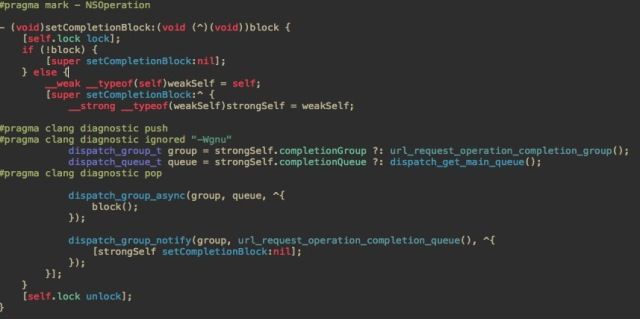有幸拜读了[一生X命]分享的文章仿写知乎日报-主页面(Part 1),自己瞎搞一上午,封装了一个基于导航栏navigationitem.titleview的简单刷新控件。集成刷新和显示Title,支持拓展成响应事件的图片按钮。效果图还是用[一生X命]的吧。
目录
- 布局
- 功能实现
- 对打破Block循环引用的简单总结
布局思路
通过标题title去计算好Size,然后计算底层的容器视图contenView的宽高再进行布局。标题居中,左侧放菊花(高度20),右侧放一个view(用于拓展),跟菊花的位置对称。为了美观,视图之间留有space=2的空隙,如破图:
** 这里有3种情况:**
- 用title计算的size.height小于菊花的高度
- size.height大于菊花的高度
- 传入的title为nil 或者 @""时,将菊花居中
宏定义菊花的高度和空隙的宽度
#define JKACTIVITY_HEIGHT 20
#define JKSPACE 2
首先计算title的size
CGSize size = [title boundingRectWithSize:CGSizeMake(MAXFLOAT, 44)
options:NSStringDrawingUsesLineFragmentOrigin
attributes:@{NSFontAttributeName:contenView.titleLabel.font}
context:nil].size;
CGSize newSize = [contenView.titleLabel sizeThatFits:size];// 进一取“整”,有约束时慎用此方法
再计算contentView的宽高以及titleLabel、菊花activityIndicator的中心坐标和宽高(以下是主要代码,非全部)
JPRefreshTitleView * contenView = [[JPRefreshTitleView alloc]init];
contenView.viewHeight = newSize.height < JKACTIVITY_HEIGHT ? JKACTIVITY_HEIGHT : newSize.height;
// 传title时,会将title居中,传入nil时,将activityIndicator居中。
contenView.viewWidth = size.width ? newSize.width + (2 * JKSPACE + JKACTIVITY_HEIGHT) * 2 : newSize.width + 2 * JKSPACE + JKACTIVITY_HEIGHT;
CGPoint labelCenter = CGPointMake(JKACTIVITY_HEIGHT + 2 * JKSPACE + newSize.width/2.0, contenView.viewHeight/2.0);
CGRect labelBounds = CGRectMake(0, 0, newSize.width, newSize.height);
contenView.activityIndicator.bounds = CGRectMake(0, 0, JKACTIVITY_HEIGHT, JKACTIVITY_HEIGHT);
contenView.activityIndicator.center = CGPointMake(JKSPACE + JKACTIVITY_HEIGHT/2, contenView.viewHeight/2.0);
contenView.bounds = CGRectMake(0, 0, contenView.viewWidth, contenView.viewHeight);
[contenView addSubview:contenView.titleLabel];
[contenView addSubview:contenView.activityIndicator];
viewController.navigationItem.titleView = contenView;
然后用CAShapeLayer和贝塞尔曲线创建2个圆圈,需要时再显示
- (void)addCircleLayersWithColor:(UIColor *)color{
self.backgroundLayer = [CAShapeLayer layer];
self.backgroundLayer.anchorPoint = CGPointMake(0.5, 0.5);
self.backgroundLayer.strokeColor = [UIColor lightGrayColor].CGColor;
self.backgroundLayer.fillColor = [UIColor clearColor].CGColor;
self.backgroundLayer.position = self.activityIndicator.center;
self.backgroundLayer.lineWidth = 1.5;
self.backgroundLayer.strokeStart = 0;
self.backgroundLayer.strokeEnd = 1.0;
CGRect bounds = self.activityIndicator.bounds;
//bounds.size.height -= 2;
//bounds.size.width -= 2; //对应cornerRadius:JKACTIVITY_HEIGHT/2.0-1
self.backgroundLayer.bounds = bounds;
UIBezierPath * backPath = [UIBezierPath bezierPathWithRoundedRect:bounds cornerRadius:JKACTIVITY_HEIGHT/2.0];
self.backgroundLayer.path = backPath.CGPath;
self.foregroundLayer = [CAShapeLayer layer];
self.foregroundLayer.anchorPoint = CGPointMake(0.5, 0.5);
self.foregroundLayer.strokeColor = color ? color.CGColor : [UIColor darkGrayColor].CGColor;
self.foregroundLayer.fillColor = [UIColor clearColor].CGColor;
self.foregroundLayer.position = self.activityIndicator.center;
self.foregroundLayer.lineWidth = 2;
self.foregroundLayer.strokeStart = 0;
self.foregroundLayer.strokeEnd = 0;
self.foregroundLayer.bounds = bounds;
self.foregroundLayer.path = backPath.CGPath;
[self.layer addSublayer:self.backgroundLayer];
[self.layer addSublayer:self.foregroundLayer];
[self hideCircleLayer];
}
- (void)hideCircleLayer{
self.backgroundLayer.hidden = YES;
self.foregroundLayer.hidden = YES;
}
- (void)displayCircleLayer{
self.backgroundLayer.hidden = NO;
self.foregroundLayer.hidden = NO;
}
用于拓展的rightView属性对外公开,但是重写setter方法控制大小。通常在titleView上增加按钮都会带上文字,所以不考虑传入空title时的布局,只需考虑左右对称。
- (void)setRightView:(UIView *)rightView{
if (_rightView) {
[_rightView removeFromSuperview];
_rightView = nil;
}
rightView.bounds = CGRectMake(0, 0, JKACTIVITY_HEIGHT, JKACTIVITY_HEIGHT);
rightView.center = CGPointMake(self.viewWidth - JKACTIVITY_HEIGHT/2.0 + JKSPACE, self.viewHeight/2.0);
_rightView = rightView;
[self addSubview:_rightView];
}
实现功能
通过KVO监测scrollView/tableView/collectionView的contentOffset
**
对外公开的方法可以传入viewController以及UIScrollView继承体系对象。viewController用处不大,主要为了内部实现设置navgitionItem.titleView,引入scrollView是为了在控制器释放后还能移除KVO,以及监测contentInset**。关键代码如下,
@property (nonatomic, strong)UIScrollView * scrollView;
+ (JPRefreshTitleView *)showRefreshViewInViewController:(UIViewController *)viewController
observableScrollView:(UIScrollView *)scrollView
title:(NSString *)title
font:(UIFont *)font
textColor:(UIColor *)textColor
activityIndicatorColor:(UIColor *)activityIndicatorColor;
if (scrollView) [scrollView addObserver:contenView forKeyPath:@"contentOffset" options:NSKeyValueObservingOptionNew context:nil];
// 避免内存泄露
- (void)removeJPRefreshTitleView{
[self stopRefresh];
if(self.scrollView) {
[self.scrollView removeObserver:self forKeyPath:@"contentOffset"];
self.scrollView = nil;
}
if (self.rightView) self.rightView = nil;
}
- (void)dealloc{
[self removeJPRefreshTitleView];
JKLog(@"%@被释放",[self class]);
}
实现KVO的回调方法,以实现实时监测ScrollView的滑动偏移。这里增加三个属性配合使用,因为系统优化机制viewController.automaticallyAdjustsScrollViewInsets及手动设置contentInset都会改变距离顶部的偏移量,所有咱用marginTop来记录scrollView/tableView/collectionView的contentInset.top,contentInset会影响内容的内嵌显示,contentOffset则影响内容的偏移,而我们要监听计算的实际滑动偏移是两者之和,即CGFloat newoffsetY = offsetY + self.marginTop,最开始为0。刷新的临界点threshold,向下拖动的偏移【绝对值或者距离】超过80松手后就刷新,实际数值是-80。
@property (nonatomic, assign)CGFloat marginTop;
@property (nonatomic, assign)CGFloat threshold;
@property (nonatomic, assign)CGFloat progress;
- (void)observeValueForKeyPath:(NSString *)keyPath ofObject:(id)object change:(NSDictionary *)change context:(void *)context{
if ([keyPath isEqualToString:@"contentOffset"]) {
// 实时监测scrollView.contentInset.top,存在系统优化机制时为-64,关闭后为0(不包括手动设置的情况)
if (self.marginTop != self.scrollView.contentInset.top) {
self.marginTop = self.scrollView.contentInset.top;
}
if (self.isRefreshing) return;
CGFloat offsetY = [change[@"new"] CGPointValue].y;
// 栗子:存在系统优化机制时scrollView.contentInset.top = 64,而scrollView.contenOffset.y= -64
// 相加之和,即newoffsetY便是我们要算的实际偏移,最开始等于0(向下拖时,newoffsetY < 0)
CGFloat newoffsetY = offsetY + self.marginTop;
// -80 0){ // 一直向上拖
self.progress = 0; // KVO有点延迟,滑动过快会导致越过0点后progress >0。
}else if (newoffsetY >= self.threshold && newoffsetY <= 0) {
self.progress = newoffsetY/self.threshold;
// 临界点,松手后开始刷新
}else if (newoffsetY < self.threshold && !self.scrollView.isDragging){
[self startRefresh];
self.progress = 0;
}else{ // 超过临界点,但是还在拖拽
if (self.progress > 0 && self.progress < 1) {
self.progress = 1; // KVO有点延迟,拖拽过快会导致越过临界点后progress <1。
}
}
}else [super observeValueForKeyPath:keyPath ofObject:object change:change context:context];
}
// 重写progress的setter方法,在这处理进度条圆圈的显示和隐藏
- (void)setProgress:(CGFloat)progress{
if (_progress == progress) {
return;
}
_progress = progress;
if (progress == 0) {
[self hideCircleLayer];
// 松手后才能隐藏
} else if (progress == 1 && !self.scrollView.isDragging){
[self hideCircleLayer];
}else{
[self displayCircleLayer];
}
// 这里处理进度条回退的动画,分拖拽回退和自动回退的动画,分别使用线性和缓慢结束的效果,看起来比较流畅。
[CATransaction begin];
[CATransaction setDisableActions:NO];
if (self.scrollView.isDragging) {
[CATransaction setAnimationDuration:0.15];
[CATransaction setAnimationTimingFunction:[CAMediaTimingFunction functionWithName:kCAMediaTimingFunctionLinear]];
}else{
[CATransaction setAnimationDuration:0.25];
[CATransaction setAnimationTimingFunction:[CAMediaTimingFunction functionWithName:kCAMediaTimingFunctionEaseOut]];
}
self.foregroundLayer.strokeEnd = MIN(progress, 1);
[CATransaction commit];
}
对Block循环引用的一点小总结
开发中很多时候都会用到Block,但是block容易引起循环引用。比如下面这种写法,self强引用JPRefreshTitleView ,而JPRefreshTitleView 的refreshingBlock又会强引用self,就形成了循环引用,造成内存泄露。
self.refrshView = [JPRefreshTitleView showRefreshViewInViewController:self
observableScrollView:self.tableView
title:@"JPRefreshTitleView"
font:[UIFont systemFontOfSize:18]
textColor:[UIColor blackColor]
refreshingBlock:^{
[self.tableView reloadData];
[self endRefresh];
}];
为了少敲点强弱转换的代码并在block里面直接用self,尝试着在JPRefreshTitleView内部做点手脚,几经折腾,最终还是选择用转换self强弱引用的方法。
为了打破循环引用,通常我们选择转换成weakSelf
__weak typeof(self) weakself = self;
但是这种写法有个缺点,就是self过早释放造成weakSelf置空,block回调容易crash。为了避免过早释放self,可以在block里面进行强引用转换。block执行完了后都会被释放掉,这样既能避免block循环引用,又能避免self过早释放。
__strong typeof(weakself) strongself = weakself;
能不能再懒一点,少敲点代码?当然可以,在网上搜到了强弱转换的宏,但不知咋个回事,从网上拷贝的宏定义不能用,然后自己瞎搞了下,又能用了。需要弱转换时输入:
WeakSelf; 或者 Weak(self);
在block里面强引用输入:
StrongSelf; 或者 Strong(self);
然后就可以直接用self了。其实这个self就是上面的strongself ,曲线救国,命名为self而已。当然上面的strongself 也能命名成self,于是就有下面三种混搭写法:
WeakSelf; // Weak(self); // __weak typeof(self) weakself = self;
self.refrshView = [JPRefreshTitleView showRefreshViewInViewController:self
observableScrollView:self.tableView
title:@"JPRefreshTitleView"
font:[UIFont systemFontOfSize:18]
textColor:[UIColor blackColor]
refreshingBlock:^{
StrongSelf; // Strong(self); // __strong typeof(weakself) self = weakself;
[self.tableView reloadData];
}];
另外一种方法可以借鉴AFNetworking里面的用法,但是这种方法只适合一次性的Block,用完就会置为nil.即相当于在JPRefreshTitleView内部调用完refreshingBlock就执行refreshingBlock=nil;但是JPRefreshTitleView的block是多次调用的,所以不能用完一次就置为nil,只能选择用强弱转换self的方法。关于AFNetworking里面的用法可以参考知乎的一些答案:为什么系统的block,AFN网络请求的block内使用self不会造成循环引用?
这是我修改后的宏定义,可以直接用(ARC模式亲测可以,MRC没测试)
#ifndef weak_self
#if __has_feature(objc_arc)
#define WeakSelf __weak __typeof__(self) weakself = self;
#else
#define WeakSelf autoreleasepool{} __block __typeof__(self) blockSelf = self;
#endif
#endif
#ifndef strong_self
#if __has_feature(objc_arc)
#define StrongSelf __typeof__(weakself) self = weakself;
#else
#define StrongSelf try{} @finally{} __typeof__(blockSelf) self = blockSelf;
#endif
#endif
#ifndef Weak
#if __has_feature(objc_arc)
#define Weak(object) __weak __typeof__(object) weak##object = object;
#else
#define Weak(object) autoreleasepool{} __block __typeof__(object) block##object = object;
#endif
#endif
#ifndef Strong
#if __has_feature(objc_arc)
#define Strong(object) __typeof__(object) object = weak##object;
#else
#define Strong(object) try{} @finally{} __typeof__(object) object = block##object;
#endif
#endif
第一次在上发表文章,其实也没啥技术含量,但是开了个头,就会继续写下去,初出茅庐,还望各位同行多多指教。有了前辈的思想,封装起来并不难,通过KVO监听偏移和实现刷新,注意Block循环引用和移除KVO就行。难理解的地方应该是计算实际偏移,存在优化机制和手动设置时会影响内嵌和偏移量,所以要通过抵消来计算实际偏移。PS: 手动设置tableView的contentInset需要在viewDidAppear方法里面实现。
GitHub
目前只支持监听一个tableView,后续会继续更新以支持监听多个tableView。

